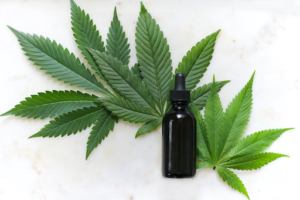Making Delta 8 THC: Step-by-Step Guide to Making Delta 8 THC
If you believe delta 8 THC is created by alchemy or mysticism, you should double-check your assumptions. In actuality, the production of delta 8 THC is a lot simpler procedure than one might imagine; yet, there are specific hazards and measures to comprehend. Contemporary Delta-8 THC products are not derived from plants but are manufactured in a laboratory. Below is an overview of how Delta-8 THC is synthesized in the laboratory from hemp-extracted CBD.
What you should know
Delta-8-THC (also known as D8) is a moderately intoxicating cannabinoid in industrial hemp and cannabis. Its molecular composition is quite close to delta-9-THC (something that most individuals consider and call “THC”). However, it is a different cannabinoid with its set of features.

Procedure to Make Delta 8 THC
Converting CBD to Delta-8 is not a novel phenomenon. G. R. Webster, Leonard Sarna, and Raphael Mechoulam trademarked this thermal decomposition procedure generations earlier. The below process is based on the UVM Cannabis Research. The research demonstrated how THC and CBD are quickly converted into Delta-8 via a chemical process. When it comes to how to make delta 8 distillate, CBD is a more straightforward procedure with little solution cleaning and byproducts at the conclusion. As a result, the following formula is centered on CBD.
1. Put CBD In Your Preferred Solvent
Unlike other cannabis extraction procedures, such as ethanol-based approaches, Delta-8 conversion needs a non-polar chemical agent such as Alkanes (specifically heptane).

2. Stir the Acid of Preference into the Solvent Mixture
Incorporate acid into the solvent solution. Retain the mixture at 100 ° C while stirring for 18 hours (hot stirrer plate needed). Alumina acid-washed, p-toluenesulfonic acid, and hydrochloric acid are all popular solvents (known as Lewis acids).
3. Various Solvents Combinations Produce Distinct Outcomes
There seems to be a plethora of various configurations that can all convert CBD to Delta-8. Every procedure produces unique outcomes. The chemical reaction takes roughly one to Eighteen hours, depending on the combination.
It may also create various byproducts and leave a range of residues that must be cleaned up. Understand that two alternatives are hydrochloric acid in ethanol and sulfuric acid in cyclohexane. Toluene and p-toluenesulfonic acid are two prominent choices.
4. Laundered and Dried
After the chemical reaction and the upper phase has been isolated, the mixture must be washed and neutralized. You should clean it with an aqueous 5% NaHCO3 solution (Sodium bicarbonate).
5. Testing is Essential
The cleaned, transformed mixture is segregated into various cannabis components using high-performance liquid chromatography (HPLC). Throughout the procedure, testing is essential to ensure purity. Transformation is rarely 100% accurate. A range of byproducts will always exist.
Obtaining Delta-8 via A Cannabinoid Transformation
Understand that every Cannabinoid starts as Cannabigerolic acid (CBGA). Such a chemical, regarded as the “parent of all cannabinoids,” transforms during the plant’s life cycle into each organic Cannabinoid presently known, from THC to CBD and beyond. Genetics, environmental triggers, and tension can influence such biological transformations.
Since cannabinoids have relatively identical chemical structures, transferring this natural inclination to transition from one to the other into the lab is extremely simple. Years before Delta-8 became famous, lab workers used the same transformation procedures to turn normal cannabinoids into uncommon, exotic ones. The technique is currently being used for Delta-8.
Delta-8 is present in several cannabis cultivars, albeit at relatively low concentrations. Extraction and purification of Delta-8 from raw plant material with less than 1% of the required Cannabinoid are expensive. Manufacturers have started converting other, more popular cannabinoids like cannabidiol (CBD) and tetrahydrocannabinol (Delta-9 or THC) to Delta-8. However, this is not the sole cause for the increase in Delta-8 manufacturing.

An additional factor is the exploding CBD business. With a glut of CBD currently overwhelming the markets, manufacturers have discovered that they have surplus CBD and excessive Delta-9, owing to THC remediation techniques. CBD and Delta-9 are both excellent choices for conversion into Delta-8. Delta-8 is now more lucrative than CBD. Furthermore, it slips under a legal technicality and escapes the same punishment as its sibling, Delta-9.
Converting DELTA-8 from CBD using the most miniature tools
Various home chemists have frequently proved how simple it is to convert CBD to Delta-8. CBD extract is transformed into a high-inducing molecule using a home-chemistry kit and readily available solvents and acids. Regrettably, this is also a disadvantage of Delta-8 THC: most beginners and garage scientists are producing synthetic cannabinoids, and most of their offerings may include leftover compounds. Acetic acid, for instance, is a typical chemical utilized to produce Delta-8 THC. As per epidemiological statistics, when one inhales acetic acid, it can be pretty harmful. Users may absorb more than they think if the Delta-8 producer fails to conduct the procedure correctly.

Conclusion
Now you understand that Delta-8-Tetrahydrocannabinol (Delta-8) is a naturally existing cannabinoid increasingly being synthesized in laboratories. The sudden ‘legitimate’ high is the newest Cannabinoid to be treated with cannabidiol (CBD). Such implies irrepressible consumer demand, which has escaped federal oversight so far. So, where is this unique Cannabinoid derived? It is indeed due to an abundance of many other, more prominent cannabinoids. Delta-8, made from hemp, navigates legal and semantic pitfalls, but it is also relatively inexpensive to make in a laboratory.

